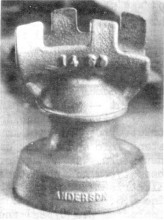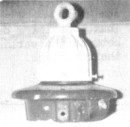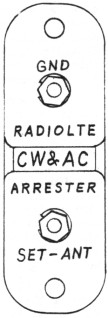Porcelain Insulator News
by Jack H. Tod, NIA #13
Reprinted from "INSULATORS - Crown Jewels of the Wire", May 1980, page 22
Dear Jack:
... but came across an unimportant insulator
that interested me. I've tried every way to make something other than U-241A out
of it, but haven't succeeded. Did Pittsburg make this style other than for J-M?
I've had only one of those with the JOHNS-MANVILLE marking, and it sold first
thing off the list, so it's been a long time since I've seen one. But as I
remember, this one is identical except for being unmarked. It's somewhat crude,
with a blotchy brown glaze but very perfect thread.

It came off an S.P. signal
line, being in company with hundreds of newer and super-common O-B's....
N. R.
(Woody) Woodward
Houston, Texas
- - - - - - - - -
Dear Woody:
Yes, the unmarked U-241A specimens
are same as the ones with the J-M marking and they were made by Pittsburg, being
their catalog No. 14-1/2. Even the unmarked ones are not common items, but they
have been available in collector circles for a long time.
Jack

Dear Jack:
I collect mainly glass, and I am always trying to obtain info about Chicago
pieces, either those embossed as such or ones used extensively in the city.
Enclosed is a photo of such a piece.
I wrote Mr. Woodward about it, because of
his Chicago background, but he could not help and thought I might ask you.
Finding the insulator is a whole lot simpler than finding the info on it. I'd
even settle for an educated guess on it at this point!
The insulator is
4-3/16" wide by 5-1/2" tall. very heavy cast iron with a composition
insulating material interior. On the back side of skirt it's embossed with a
Circle-A. Underneath near the threads is "ALBERT & J. M. ANDERSON M.
Co. BOSTON MASS. U.S.A. A(circled)". The piece was obtained from an area collector
and after showing it to a railroad buff stated he has seen many along the South
Shore line, but none with any embossing. I don't know if I can buy that
statement. Possibly in your travels you have seen the piece and could help me
out with info an age, rarity, and if indeed it is only to be found around here.
Michael Sovereign, NIA #1548
Bartlett, Ill.
- - - - - - - - - -
Dear Michael:
Wow, your Anderson
item is really a beauty. They made so many different composition and
metal/composition combination types (many with company markings) that it would
be nice if someone would make a specialty collection of them.
I never noted
these on eastern trips, but I was usually on a rush-rush schedule and largely
confined to motel-row streets. I'd think one would be liable to find these and
other old trolley and electric railroad insulators in many of the larger and
older cities of the country. Years ago Phoenix and Tucson did have a small
Toonerville Trolley, but we largely skipped that era by going right from horses
to Chevrolets -- and possibly back to horses next year again if alfalfa and oats
remain so much cheaper than gasoline. We won't have to inhale exhaust fumes
then, but we'll try to be careful not to step in the exhaust.
We pictured one
interesting Anderson pin type in the Sept. 1977 CJ (page 29), and yet another
one in last month's issue. They also made the combination metal/composition type
with a large cap screwing down on to a pair of large ears on the crown part
(Pat. 522,175 of June 26, 1894).
Albert & J. M. Anderson Mfg. Co.,
Boston, Mass. was established in 1877 and was located from early times at
289-293 "A" Street in Boston. Even as late as a 1953 directory, the
address was still 289 "A" St., Boston, Mass. 02110.
They had several
registered trademarks, the most commonly seen an specimens being
"AETNA" (registered #22,148, 12/6/92, used since 1/1/91). I could
never find the Circle-A in the registrations. Directories and old advertisements
indicate their product lines were railroad and trolley electrical equipment --
strains, pin types, third-rail insulators, etc.
My writing and publication work
has generally been restricted to porcelain insulators, but I did collect at
least patent info and source data on companies who made other insulators. As an
assist to anyone else wishing to research these types of insulators, I listed on
page 117 of my book "Electrical Porcelain" the names, locations and
trademarks of nine U.S. companies who made fibre or composition insulators
(including pin types) and five other companies who made "lava"
insulators. Some of the companies made such an extensive line of pin types that
collectors should be more energetic in collecting the specimens and researching
the companies. The most fruitful of the bunch would be: Albert & J. M.
Anderson; Electrose Mfg. Co.; Johns-Manville; Ohio Brass Co.; and Westinghouse.
I think Anderson is still a going concern at the Boston address given above.
They could well have on file catalogs showing all those old lines manufactured
by them in the past 90 years, not to mention gold mines of catalogs showing what
all the other competing companies made! It wouldn't surprise me if they also had
some sort of dusty closet collection of many of the old specimens they made. If
some energetic collector out there doesn't some day contact or visit this
company and publish in CJ results of their research, I'll lose faith that we
have collectors who care more about insulators than their use as door stops and
window ornaments.
Jack
Fred Wittstock (Waterloo, Iowa) recently advised us of
the following Pittsburg date code stamps on specimens in his collection: JAN 17
PAID, APR 6 Ans'd, JAN 16 Rec'd, APR 16 P.M., JUL 7 P.M. Also the following full
date stamps by Pittsburg: AUG 16 1916, APR 22 1913, NOV 7 1915.
These new coded
stamps fill in a few key slots in our puzzle to try solving the Pittsburg year
coding, but it's a bit disconcerting to note that Nov 7, 1915 was a Sunday.

Dear Jack:
My neighbor went to an estate auction and bought an insulator
for me. It's a chocolate brown, 3-piece cemented multipart, 13-1/2" wide
across the top skirt, 12-1/2" tall, weighing 30 pounds. The top piece is
incuse marked LOCKE/1956 A/ USA, and all 3 of the pieces have a white underglaze
NP marking as I've sketched.
The old guy who owned it had been using it upside
down for a planter. He used to work for the local phone company, and my neighbor
talked to a power company lineman at the auction who got the insulator for the
old man when they were changing some power lines.
It makes a nice conversation
piece, but I wouldn't want too many of them -- my floor might give way. I don't
suppose many people collect them that big. Are these types still in use? I have
never seen one like it. What kind of trade value would you put on it?
I got into
collecting insulators by accident. I was at home one day when the power company
was changing over their lines in town, and they dumped several crossarms
complete with insulators in my front yard. I asked the crew foreman if I could
have them, and he said I could have all I wanted, so I dragged home all I could
find. Probably 10 or a dozen crossarms in all. That's when I got interested in
insulator collecting.
John E. Sampson
Box 719 Platte City, MO 64079
- - - - - - - - - -
Dear John:
The "NP" marking on your massive Locke stands for "Noise
Proof" which was Locke's term originated to designate insulators receiving
special manufacturing treatment (conductive crown glazes etc.) to reduce radio
frequency interference. Without such treatment, there is a high electrical
stress at the interface between the conductor wire and the small area it touches
the insulator crown.
Most companies had their own trade term for these, such as
QT (Quiet Type) used by Thomas, ST (Silent Type) by Ohio Brass, etc. Some Locke
items have an "R" suffix in the marking, and that indicated
"Radio Freed", another term for these insulators Locke used in place
of NP starting in 1963. Oddly though, Locke (G.E. after Dec. 1968) continued to
current times to use NP as part of the catalog numbers.
Incidentally, the 1956
in your marking is their catalog number and not a date. Even so, this marking
style was used by Locke from Mar 1950 through Nov 1962.
Yes, such large pin
types are still in use on many lines, especially in the western half of the
U.S., and they are still manufactured, mainly for use as replacement item. I
believe nearly all new construction now uses "post" insulators,
either on crossarms or attached directly to the sides of the poles in various
configurations.
I don't know what the "trade value" of it would
be, but if you're going to ship it to a collector in Seattle., how about adding
up what you paid for it, plus $5 for a day's work to build a crate for it, plus
the $11.46 U.P.S. for sending a 40# crate from Missouri to Seattle?
Enjoyed very
much the interesting story of how you got started collecting. Many collectors
have similar interesting entries into insulator collecting. My interest stemmed
from the time we had to put our coin collections in bank boxes where we couldn't
look at them, and when I wanted to get out in the hills on weekends instead of
sitting at a desk licking stamp hinges on those nice spring days. I thought
other people might also collect insulators, but I'd been at it for several years
before I was able to find a book on them and before I finally met by chance
another collector.
Jack

Dear Jack:
Recently I obtained a U-934 Imperial which
has the #3 Crown trademark incuse marking, the stamped date 7-7-97, and a
marking just like #2 (with the misspelled "PROCELAIN") except for one
difference. In mine, the "B" in the word "BY" is a small
capitol letter -- the same size as the Y and the letters in MANUFACTURED except
for the larger M in that. Perhaps this will be of interest to others.
Paul Colburn, NIA #1348
Lake Worth, Fla.
- - - - - - - - -
Dear Paul:
Guess what! It took nine years
for someone to notice that the marking as shown in the book is incorrect and to
call it to our attention. I made the marking drawing in 1971 from a specimen on
which the upper right portion of the stamping didn't show, so evidently I just
guessed the "BY" started with a large letter as did the other words in
the top lines. I naturally just now checked others with very clear markings, and
they agree with yours, of course.
No small wonder you caught this error in the
book, since anyone having a U-934 is excused from studying it in great detail.
Not only is this a rare and valuable Imperial, but it is a historic classic.
These came from the first high voltage transmission line ever built in the U.S.
(Niagara Falls to Buffalo, N.Y.).
Jack

Dear Jack:
Am enclosing (at right)
a photo of an item found in an old pasture dump. What is it?
Also enclosed is a
sketch of a radio antenna lightning arrestor (1-1/4" x 3-3/4" with
dark chocolate-brown glaze). What company made it, and did they make other types
of insulators besides this one?

Of the secondary rack spools we have, I am
wondering about one with a marking of "PEIRCE 355", and another with a
marking "OLIVER 2000". What can you tell me about these? Also another
company I'm wondering about is "HUBBARD & Co.".
Carolyn Theesen,
NIA #1590
Lawton, Okla.
- - - - - - - - -
Dear Carolyn:
I suspicion the large hanging insulator
you have (photo above) is a portion of a luminary -- probably an arc light.
Your
radio antenna lightning arrester by CW&AC is by Consolidated Wire &
Cable Corp., Chicago, and is probably the only porcelain insulator made for
their resale with their company identification on it.
These items are pictured
and described on page 58 of my book "Electrical Porcelain". Although
various antenna insulators were sold singly, they were generally sold in
complete kits -- a roll of wire, an arrester, two strains, several nail knobs, a
window strap, instruction sheet. There are many markings on these arresters --
various nail order houses, wire manufacturers, radio companies.
The secondary
rack spools occasionally had markings identifying the porcelain manufacturer,
but more generally they had the names or trademarks of various poleline hardware
manufacturers who sold the complete rack assemblies -- or the spools separately as
replacement items.
The one you have is Hubbard & Co,, 6301 Butler St.,
Philadelphia, Pa. They sold all forms of poleline hardware. It's hard to
believe, but old directories show this company as having been established in
1843! They also use the tradename "PEIRCE" as a marking, plus also an
"H" within a shield. The "PEIRCE 355" rack spool you have is
a Hubbard item.
The rack spool you have with "OLIVER" is from the
company founded in 1894 as Oliver Iron & Steel Corp. of Pittsburgh, Pa. In
the early 1950's the company was liquidated, and a George C. Price bought the
poleline hardware portion of it, now known as Oliver Electrical Mfg. Co., Battle
Creek, Mich. Thus, specimens carrying the OLIVER marking can be attributed
between the earlier and later companies only by estimating their vintage.
Jack
Grant Salzman (Sacramento, Cal., NIA #1785) and I have corresponded at
length concerning the possibility of finding more "goodies" on lines
up in Canada, and especially in the remote areas yet unsearched by collectors,
and he has done some prowling up there himself, mainly in search of unusual
CD-143's which are one of his pets. Grant mentioned something in a recent letter
which I thought would be of interest to our readers, and I quote him:
"Bill
Lovely (in Regina, Sask.) has picked some purple two-piece tramps and some
porcelain U-223's, but he tells me that these were not used to transpose the
wires. He says that in Canada they would use iron wire for telephones except
where the lines crossed an intersection. They would use copper wire only to
cross the intersection. He said they would use the glass or porcelain tramps to
tie off the iron wire on one groove and begin the copper wire from the other.
Then on the other side of the intersection they would use the tramp again to
reverse the process. Bill says that most of his "finds" were on
country roads, but that he has only found about half a dozen U-223 white
porcelain 2-piece. The rest were all glass."
Grant also knows a man in
Canada who has saved at least some of the "Canadian Bostons" (glass
CD-136.4) but went on further to say,
"He is an old lineman, and he said he
has destroyed thousands of those (before they became collectible) because the
wire groove was too narrow, and the wires would slip out and 'float'. He said
their foreman told them not to save the insulator, just smash it with their
pliers! It makes me weep to think about it!"
Yes, how sad it is. Our
sportsmen association here used to conduct adopt-a-stream cleanup programs in
the early 1950's, and I remember hauling many gunnysacks of those old cone top
beer cans from the mountain areas back to Phoenix and to the dump. If I'd just
put those sacks of oldies in my attic instead, I would be pretty well off now!
Jack
| 